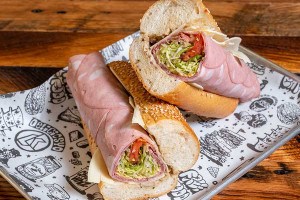A Look Back at the First Review of Le Bec-Fin
The following review appeared in the September 1974 issue of Philadelphia magazine. It is the first mention of Georges Perrier and Le Bec-Fin that we could find in the Philadelphia magazine archives. Among the interesting tidbits in Jim Quinn’s review:
- Le Bec-Fin Prix fixe was $22.
- Wine was $12-$15 a bottle.
- Georges Perrier’s restaurant was still at 1312 Spruce Street, the current address of Vetri.
- Most impressive dish, Quenelles de brochet.
- Favorite entree, rognons de veau.
- The New York Times had just named the restaurant the best on the East Coast.
- Six week wait on Saturday night reservations.
The Best and the Brightest
In 1972, I was writing a restaurant guide to New York City and spending money as fast as my publisher could ship it to me, looking for the best $100 meal in Manhattan. I went to all the biggies, comparison shopping for quenelles, sweetbreads, rognons and ballotine of duck, and I got lots of good food-—but, surprisingly, nothing as good as the food I remembered at two Philadelphia restaurants–Le Bec Fin and La Panetiére. It made New Yorkers laugh when I told them that—given the reputation of Philadelphia restaurants at the time—but time passes, and reputations finally straighten themselves out. A few months ago, Craig Claiborne, restaurant-tester emeritus for the New York Times, visited Philadelphia and declared that Le Bec Fin was the best restaurant on the East Coast. And a few months before that, John Hess, the most knowledgeable and demanding (and bad-tempered) of Claiborne’s successors, had praised Le Bec Fin just as highly—and praised La Panetiere just a little bit more.
There’s no point in trying to resolve that argument—if it is an argument about food, and not a statement of preference in ambiance and decor. It’s enough to say that Philadelphia has managed to keep two outstanding luxury restaurants in business, while most of the New York biggies I visited were headed for bankruptcy court. But (there is some point in listing the other things—besides food that make both Le Bec Fin and La Panetiére better than anything in New York.
First, money. Philadelphia restaurants pay Philadelphia rents and charge Philadelphia prices. Le Bec Fin’s fixed price is $22 a person; a meal at La Panetiére works out at something like $18 to $20 a person. That may seem like a lot—but at Lutece, the only New York restaurant which can give either of them any serious competition, I paid $30 a person~—two years ago, even before Earl Butz became Secretary of Agriculture.
Second, service. Philadelphia’s restaurants get a largely hometown business, so there is no attempt to get big tips by over-awing those tourists who know all about food because they read it in Gourmet Magazine. No glaring headwaiters, no quailing underlings, no fierce struggles of class and caste that seem to aim at recreating, table-side, the social system of pre-revolutionary France. In New York I once had a headwaiter actually curse and strike a subordinate for not cutting the wing tips from my pigeonneau. He then snatched the plate from in front of me, fussed over it for ten minutes, lovingly dismembering and disjointing, and returned it with a smile—stone cold. At both Bec Fin Panetiére the idea seems to be to to the table while it’s hot—an innovation that other restaurants in both New York and Philadelphia should consider imitating.
Third, there is no Siberia in either restaurant. Both are too small, too intimate, and essentially too democratic to bother segregating customers. So you never get the feeling that you are sitting elbow to elbow in the room, subsidizing the dining space, if not actually the dinners, of the superstars up front. You sit in the same room, are waited on by the same waiters, and get the same food, as everyone else. And you get the benefit of an attention to detail that has become impossible in New York: at La Caravelle and Le Pavillon I ate off a slightly fancy version of Saratoga never-break cafeteria plates, at Lutéce and Le Madrigal oil cheap lapanese stoneware. Le Bec Fin and La Panetiére use the same elegant Italian china—one of the many minor things that make you happier about spending your money.
So, four stars each to begin with—and a long description so you can decide which of these two very different restaurants you’ll like the best.
Le Bec Fin
????
Georges Perrier, half-owner and head chef of Le Bec Fin, seems to have a genius for publicity; hardly a month goes by without some new local journalist describing the menu, the wine cellar. or a day in the life of a famous French restaurant. As a result, Le Bec Fin is almost always booked up solid—figure on calling six weeks in advance if you want a Saturday night reservation, at least a few days for other times. Le Bec Fin seems to attract a hip under-30 crowd-—l0nghaired, expensively but unconventionally dressed; you will not be uncomfortable if you wear a tie and business suit. but you’ll be in a minority.
The decor is just a shade too elegant to be flashy. The walls are paneled in red and gold, the chandeliers and wall sconces of an odd cord and bugle design. There is a large antique mirror up front, and in the back a tapestry on which people on horseback chase one another for angry or amorous reasons. I have always thought, and still think, that this relatively small room could do with one less table; but then you’d probably never be able to get in. The only other real drawback is the air-conditioner, which gave my dinner guest goosebumps.
Drinks ($2.25) are not especially large, but very well made. This is one one the few restaurants in town where you can order a straight-up martini delivered to your table, and get it cold enough to drink. If you want to start without hard liquor, try Lillet, a French aperitif, at the same price. The wine list is extensive and expensive, but if you’re counting pennies there are a number of comparatively cheap wines ($12-15 a bottle)—and you can count on Le Bec Fin not to include anything at any price that w0n’t complement the food.
For your $22 you get five courses—appetizer. seafood. entree, cheese, dessert—and coffee. As a general rule, pick the things that require the most kitchen preparation: like mousse de turbot, a fat little slice of something like a pété made of very white and subtly flavored fish. l suppose this turbot must be frozen. since it comes from Europe, but the texture is as good as any fresh fish. On the plate with the turbot is a small serving of tart marinated cucumbers and a smooth homemade mustard mayonnaise which, like all the sauces at Le Bec Fin, seems to be made of perfectly identifiable ingredients—plus something else that makes them better. de foie de volaillc is also good, even spectacular. considering that it is a chicken liver pate made to resemble, in taste and texture, a pate de foie gras; but it is not as interesting or as pretty as the turbot mousse. Vichyssoise, served in a big soup plate, is the kind that relies on subtlety, cream and lots of leek flavor; you don’t taste it with the first few spoonfuls, and when you do taste it, it’s about a quarter way down your gullet. I like a gutsier, potatoey, vichyssoise, but many people prefer this kind to any other soup.
Quenelles de brochet are small dumplings made of pike, a fish so finely fleshed that it can be beaten to a smooth pudding texture, and they are a reasonably good sign of how seriously the kitchen takes itself. At Bec Fin they are not only listed in the fish course, as a kind of offhand arrogance, they are also the best I have ever had. A fat little cylinder comes to the serving cart bone white, and the Waiter pours the pink-orange sauce nantua overtop before he sets it in front of you. The texture of the quenelle is almost as smooth as a sauce, but it tastes delicately of pike. The shellfish-based sauce is flavorful and without a hint of the brackishness that most other sauce nantuas have. Altogether, this is the most impressive item on the menu.
Civet de langouste is tiny lobster tails, no bigger than a medium-sized shrimp, split and stewed in a dark brown sauce that is something like a very good bouillabaisse with the fish removed. This is a generous, unusual and tasty dish, but, though this seems like nitpicking, the split lobster tails have a tendency to tear raggedly, and gather up a cloudy color from the sauce. It’s delicious; but next to the pretty little quenelle, it looks, well, ugly. Snails in champagne are served in a tiny copper saucepan, in a thick garlic oil and champagne sauce which is extremely good, especially if you like your sauces salty.
My favorite entree here has always been rognons de veau: veal kidneys, fresh mushrooms, and a dark sauce with just a hint of mustard in it. If you’ve always thought kidneys were the things that made canned cat food smell so bad–welI, they are. But fresh kidneys, properly cleaned and marinated and cooked, are entirely different. I notice that organ meat is disappearing from more and more menus, because Americans think it’s sinful or something, so I urge you to order the kidneys at Le Bec Fin. If you don’t like them here, never like them. like them. You’ll also help stop the increasing Americanization of the ‘ menu, because the Earl Butz inflation seems to have changed Le Bec Fin, and La Panctiére, to that extent–more and more, the dishes are recognizable as variations of standard restaurant fare.
Of course, they are very good variations. Beef stroganoff, which I ordered because 1 have always hated the recipe back from the days when it was the perfect popular parry dish (cut beef gristle into little gnarls, add buttermilk. heat until it looks like cottage cheese and serve), was hardly recognizable at all. A small medallion of beef, looking like a three-quarter inch fillet, was cooked to order, a very rare French rare. and covered with a sauce flavored almost as much with tomato and beef stock as sour cream. The sauce was smooth, unseparatcd. uncurdled, and delicious; the meat was tender and tasty. certainly the best steak l’ve had in any local restaurant.
Caneton bigarade is duck with lots and lots of an extremely good orange sauce. The duck is flavorful and firm fleshed enough to show that it has never seen the inside of a supermarket frozen food bin. The only trouble with this dish is that it is not really served with the kind of style that it deserves. The waiter simply takes it out of the warming pan and puts it on your plate–two pieces. a breast and wing. a belly and leg. l don’t see any reason why you shouldn’t get a whole half duck, and a little less bone. Pureed peas come with all entrees. and they arc good. whipped to that magical smoothness of the sauces, but taste a little sugary.
The cheese course is very small, and seems designed to give everybody a chance to catch his breath before plunging on to dessert. But the cheeses are at just the right temperature, and include such relatively unusual and delicious things as Pont l’Evéque.
Desserts come from a cart, and you can mix two without raising the price of your meal. Whatever fresh fruit is available is served in a mildly boozy sauce flavored with the fruit itself. Fresh raspberries and fresh strawberries are both excellent this way. Grand Marnier is soft and custardy. heavily flavored with Grand Marnier, and extremely good. S0 is the light and delicious orange cake. Chocolate mousse is very soft. and. to me. a little oversweet, though still very good. Coffee ls included in the price of the meal. meaning that you can expect to get out of here. counting a cheap with. a 20% tip. and a couple of dollars for the headwaiter. for something like S35 a person. That is about twice what a good medium price restaurant would cost. If you’re the kind of person who eats out regularly twice a week (or month). stay home one night, and you can try Le Bec Fin without significantly denting your budget. It’s worth the money. LE BEC FIN, 1312 Spruce Street, PE2-3000. Dinner only seatings at 6 and 9. No cards.


